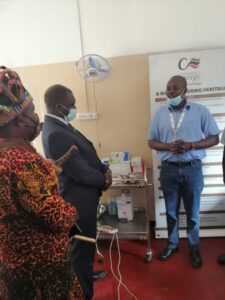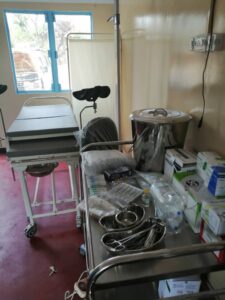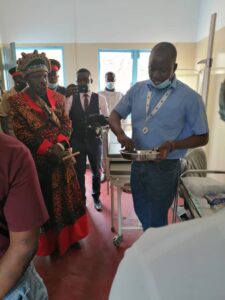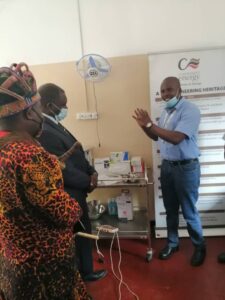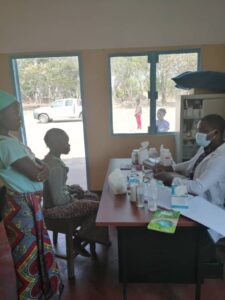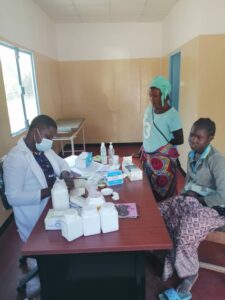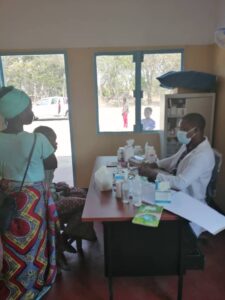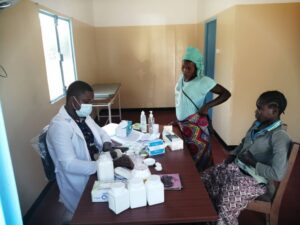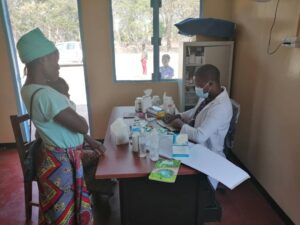A toast to health: CEC and Kanyikezhi Village celebrate first health post
To Ms. Queenice Kalezhi, a 50 year-old mother of six, giving birth at home is an all too familiar experience as all her children were birthed at home away from professional health care. It is not that she enjoyed it or that she was always somewhat unprepared for the arrival of her little ones such that she failed to get to the clinic on time but because residing in Kanyikezhi Village in Mwinilunga District of North-Western Province, a clinic is a rare privilege that many an urban dweller often and easily take for granted. It is perhaps her own experience that got her to train as a traditional birth attendant in 2003.
In her 17 years of duty, she recalls with mixed feelings both the successful and the not-so-successful home births she has attended to. Kalezhi narrates that home birthing is the norm in Kanyikezhi Village and, as a birth attendant, one encounters several challenges during the process. These range from still births and, in worst case scenarios, death of either the mother or both mother and child as all efforts to save them unfortunately fail.
“As a traditional birth attendant, I have attended to an average of 10 home births in a month. Unfortunately, not all of them end well despite one’s best effort. One of the things you learn is to identify danger signs in a pregnancy that may lead to complications, with the common one being excessive bleeding of the mother, which is not always easy to contain and if mismanaged can lead to death. Hence, once you identify those signs the right decision is to advise the family to immediately take the pregnant woman to a hospital for professional medical care, Unfortunately, it does not help if a pregnant person faced with complications seeks help too late,” she says.
The above scenario is what made the official commissioning of the Kanyikezhi rural health post on 22 September 2020 a historic and jubilant occasion which marked a new chapter in the community’s story of challenging access to health care facilities since time immemorial.
“Kanyikezhi is a catchment area for CEC’s Kabompo Gorge Hydroelectric project and today, we could not have chosen a better place to be but here, celebrating this positive development. Hence, our financial and material contribution to the hosting of this ceremony. The commissioning of this health post today is most exciting to us as it is a shared dream come true. CEC holds the belief that ‘health is wealth’ and access to health care services is the first step to achieving that,” said CEC Senior Manager, Socio-Economic Development, Mrs. Dorcas Phiri.
In 2008, CEC was awarded rights by the Government of the Republic of Zambia to undertake feasibility studies for the development of the greenfield Kabompo Gorge Hydroelectric Power Project located in Kanyikezhi Village. In 2009, the Company moved into this area in a quest to expand its contribution to the growth of Zambia’s power sector. To date, CEC has invested considerably in the social and project-related infrastructure development in the area.
According to Mwinilunga District Health Director, Dr. Brian Mwachisowa, Kanyikezhi rural health post will cater to 2, 518 people.
“The vision of the Ministry of Health is to provide equity of access to cost-effective quality health care as close to the family as possible. I am, therefore, delighted that the opening of this facility is going to alleviate the suffering of the people of Kanyikezhi community, who have been walking a long distance to Lumwana Health Centre to seek health care,” explained Mwinilunga District Health Director, Dr Brian Mwachisowa.
Dr. Mwachisowa noted that for some time, access to regular health care services by the Kanyikezhi community had been made possible by the partnership between Mwinilunga District Health Office and CEC, where the privately owned power utility provided resources to enable health care providers from Mwinilunga District hospital to travel to the village and provide disease screening, family planning, antenatal and under five clinic services.
“When CEC first came into this area; we did not only see what was lacking in terms of development but also saw human potential and a community determined to achieve socio-economic progress. As such, we sought to nurture partnerships with various actors to collectively bring about positive change. One such partnership is with the Ministry of Health to facilitate the provision of periodic health outreach sessions in this area as a means of bringing closer health care services to the people, which had been lacking all along,” said Phiri.
“Since the start in 2014, the health outreach initiative has not only brought quality health care services close to home in Kanyikezhi but has also raised community awareness about diseases such as cervical cancer and malaria that were previously little known to the people. Since then, and on a monthly basis, we have worked closely with the Mwinilunga District Health Office to assist in the transportation of the Lumwana West Clinic health staff to Kanyikezhi to conduct their monthly antenatal and under-five clinics.”
Mr. Richard Kazunda recounted with excitement how life, in the village he has lived since 1987, had indeed changed for the better.
“It is somewhat funny to imagine that not long ago, accessing medical care such as antenatal and under-five services was a three-day long affair. One needed almost a full day to walk about 32 kilometres to the roadside to hike to the hospital, then spend a night waiting to access the services the following day and then another day of walking back home. This meant one had to carry beddings, a change of clothes and food. Now you can imagine, that is three days taken away from home, what became of the young children one left at home? Farming activities, the economic mainstay, also stalled”, recalled Kazunda.
For pregnant women going to deliver at the hospital, distance is not the only worry, but also the possibility of giving birth along the way. To mitigate the risk, the women have to be accompanied by a traditional birth attendant and a minimum of two other people to assist one to give birth in the middle of nowhere if the situation came to that. If a family has a bicycle, one must cycle part of the distance to at least meet the new mother and child halfway on their way back home.
In the rainy season, the story took a different twist as the makeshift bridges across several streams that one had to across could be found under water, or worse, washed away. Walking the narrow path after a downpour, the tall grass along the path would surely leave one wet such that by the time they got to the roadside, the person is a very unattractive prospect to chance a lift. For who would want to have them in their car when they were all soaked through! So, the best thing to do was to carry extra clothing to change into just before hiking a ride.
But since 2009 when CEC moved into this area the change is evident, accessibility has improved as a result of better roads and bridges that CEC constructed in 2011. The financial benefits that most people in the area realised from the Company’s successful compensation, in 2015, of those affected by the project created some entrepreneurs who are now running small businesses and supporting their families.
“Without roads and bridges, how was this area going to be accessed to deliver building materials for this health post to be constructed?” Kazunda asks.
As chairman of Kanyikezhi Village Resettlement Committee, structures that CEC helped form to enhance partnership between the Company and the community, he is fully alive to all of CEC’s contribution to the area and anxiously looks to a future where the Kabompo hydroelectric project would be actualised and the village transformed into a town with modern amenities.
As he drives the author and her team back to the camp at the end of the ceremony, Kazunda, beaming with pride, reminds us how transportation in the village had improved.
“As you can see, I now own a motor vehicle and can drive. You may also have noticed that most people in this area now own motorcycles, which are a reliable means of transport. This is all because we have a lot of trading going on in the area, people now have disposable income, we can produce crops such as beans, cassava and pineapples and sell whereas in the past, excess yields went to waste because just like the area was not easily accessible so was the market for our produce unavailable.”
He also pointed to the support that CEC had rendered to the local school to get it certified as an examination centre, leading to an improved pass rate as learners no longer needed to travel long distances to other schools to write examinations. With that development, adult learning had become attractive with several women in the area going back to school.
“Even before this project has taken off, lives have been considerably transformed for the better, one can only imagine how things will improve once it is completed. I believe commercial activities will increase, we have immense agricultural activities that are yet to be fully actualised and with the creation of a dam, fishing is another activity that will improve nutrition for the local people.”
Senior Chief Sailung’a hailed CEC’s contribution to the economic development of the area; efforts, he said, had opened the area to increased commercial activity owing to improved accessibility and communication services.
Th senior chief, who graced the occasion, acknowledged that CEC had on several occasions availed an ambulance to the community, thus, saving lives. He stressed that such services had only been made possible with the availability of an upgraded road that had made transportation by motor vehicle possible.
The traditional leader encouraged his subjects to advance their education so that they could in turn be qualified enough to render health care services to their community, whose culture and challenges they were familiar with.
Further, realizing that women are mostly the ones who bear the burden of disease at home and in the community, which usually negatively impacts their livelihoods, CEC has empowered women with economic opportunities by assisting them to form clubs and market linkages. One such project is the cassava growing project intended to grow and supply cassava on a large scale. CEC has linked the clubs to a company in Kalumbila which is expected to buy their produce.
A community representative, Mr. Joe Kakoma, urged the government to provide CEC with the support required to move the Kabompo Gorge Hydroelectric Project to full-scale implementation so that employment may also be provided to the local community, which has remained highly expectant of the project’s progression.
“CEC is a Zambian owned company that needs government backing to succeed as its ability to support the community is dependent on that,” he said.
Mwinilunga District Commissioner, Mr. Arnold Mapulanga said the government recognised that delivering inclusive and equitable development to all Zambian citizens requires concerted efforts and commitment of all stakeholders, hence, it remains committed to the socio-economic development of the country by improving access to health services for all Zambians.
“In recognition of the fact that economic productivity depends on a healthy citizenry, the government is determined to transform Zambia into a nation of healthy and productive people. To this end, health is a top priority in human capital to drive the socio-economic development agenda. Thereby, emphasis will be placed on robust construction of health infrastructure to enhance health care delivery,” he assured.
A sketch performance by a group of evidently relieved and jubilant women, depicting them struggling in despair to get a pregnant woman in labour to the hospital paints a very clear picture of what the community had been through and their excitement at the relief that has come.
Event in pictures
